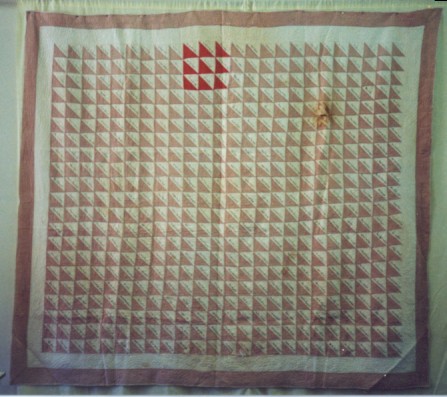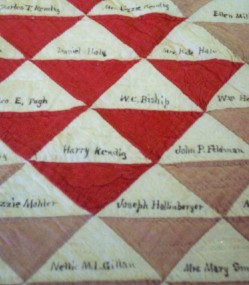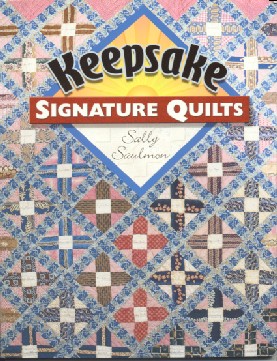|
The expansion westward brought on the need for signing quilts and autograph books. It
gives me pause each time I remember that westward expansion at that time may be a
move to Ohio from Massachusetts! The far western states were still a journey too
far for most families to undertake until the California Gold Rush. The lure of
gold in the 1850s changed the minds of many Easterners who came across treacherous
miles of mountains and
wilderness to find their riches. Research tells us few quilts were actually made
while on this treacherous journey, but many were brought to keep them warm on
the way and fill their new home. (Treasures in the Trunk, Quilts on the
Oregon Trail, Mary Bywater Cross, 1993)
The early signature quilts were based on friendship and made as memorials for
the leaving family. The 1840s and 50s was
the era of sentimentality. Poetry verses, autograph books, music and
illustrations reflect a leaning toward the romantic and nostalgic. A look
to one's mortality led to the desire to capture through the written word the
essence of a friendship. Journals, diaries, scrapbooks, autograph albums, photos, and signed
quilts reflect this sentimental time. Many of these memory saving hobbies were
taken up once again in the late Victorian period, but not signature quilts.
Instead, women would place their memorials on silks and velvets in crazy quilts.
Printed commemorative ribbons, embroidered pictures and sayings, sun printed
photos and other memorabilia embellished these patchwork quilts so popular
between 1876 and 1900.
ca. 1870 church fundraising signature quilt bought in eastern Missouri
(detail view below)
 When money was needed to help soldiers in the Civil War, women developed the
practice of raising funds with quilts. These quilts raised money via raffles
or by charging the signer a fee per signature. Sometimes an entire family would sign
one block each. More often a
quilt was signed with hundreds of signatures and then
raffled off, bringing in as many funds as possible from a single quilt. Stories are told about quilts being re-donated by raffle
winners, two or three times over, so that the one quilt could make as much money as
possible for the cause they all believed in. When money was needed to help soldiers in the Civil War, women developed the
practice of raising funds with quilts. These quilts raised money via raffles
or by charging the signer a fee per signature. Sometimes an entire family would sign
one block each. More often a
quilt was signed with hundreds of signatures and then
raffled off, bringing in as many funds as possible from a single quilt. Stories are told about quilts being re-donated by raffle
winners, two or three times over, so that the one quilt could make as much money as
possible for the cause they all believed in.
Women were known to place their political and religious beliefs on quilts. The
glorious Baltimore album quilts have sayings, bible verses, and drawings inked
on many of the blocks. These quilts were not made to be raffled that we know of.
Instead, they were made as a special gift for a particular individual in the
community that was respected for their contribution to the community in some
way.
Their name, the names of the quilt makers, and other information or sentiments would be placed on
Baltimore Album quilt blocks; some, not all, but particularly the center
block.
19th Century Ink Signatures
Signature quilts are a phenomenon that occurred before the discovery of a perfected non-fading, non-bleeding,
indelible ink. Several "recipes" were developed between 1834
and 1840. Britain gave three patents between 1837 and 1840.
A new understanding about the cause of the signature
quilt fad and its relationship was discussed in Barbara Brackman's recent
(Sept. 11, 2005) digital newsletter.*(Reprinted with permission from
Barbara
Brackman, The Quilt Detective: Clues in the Needlework, 2005, digital
newsletter, #29 - Inked inscriptions.) In this issue she
revisits her earlier research that credited Payson's invention of an indelible
ink in the mid-1830s as main reason friendship quilts with
signatures came into fashion in 1840.
"[Dr. Margaret] Ordoñez’s research into ink
composition indicates that there is no such clear-cut date for non-corrosive,
commercial inks. She notes 'the search for permanent inks that did not damage
paper and fabric was ongoing throughout the nineteenth and into the twentieth
century.' She includes a reference as late as 1913 lauding a welcome new
non-corrosive ink for laundries . . . Ordoñez found several patents for carbon
inks issued in Britain in the late 1830s."
Barbara writes that in light of this research it
seems unlikely that it was a change in ink that led to the fad for signing
quilt blocks. Her stance now is that the era at that time was more influential
than the changes in ink's indelibility than she had previously thought. The style of signing friendship blocks with ink begins as early as
1839 in Barbara's database, but quilts were signed with ink beginning in the
early 1830s.
(I highly recommend subscribing to Barbara's digital newsletter.
Read more about it here
www.barbarabrackman.com)
Margaret T. Ordoñez is a professor in the Textile
and Clothing Department at the University of Rhode Island and she heads up
their conservation lab. For more detailed information about inks and their
effect on fabric, read her research paper “Ink Damage on Nineteenth
Century Cotton Signature Quilts,” in Uncoverings 1992,
(San
Francisco, American Quilt Study Group, 1993).
Iron sulfate and nut gall (gall forms around wounds on the bark of oak trees and
to encase gall wasp's eggs)
were combined to form the basic ink used throughout most of the 19th and part of
the 20th century. In the early years, the problem arose when the tannic acid in
the gall would harden cellulose fibers in fabric and paper. A chemical
reaction called hydrolysis would occur causing the cellulose fibers to degrade.
It also caused damage to occur overtime. Water and light helped the degrading
along. The earliest signed blocks show the remaining ink smeared or almost
invisible. People tried some other rather interesting elements to
make ink. These included indigo, Prussian blue, silver nitrate, madder, potash
with wood tar, and lampblack mixed with either linseed oil, or borax and
shellac. India ink, made from carbon, and sometimes mixed with diluted
hydrochloride acid, seemed to be the most resistant to fading when wet and
soapy.
ca. 1870
fundraising signature quilt close up
 Signatures, drawings, dates,
and verses were tiny in the early years. They were applied to the fabric using
stencils, stamps or freehand. Stencils were made from copper, tin or nickel. A
lady would have one made for herself that portrayed her sense of style. It may include a design, like a feather or fancy
circle around her name, or just be simple block letters. These were used to
label their clothes and linens too, a common practice when women washed their
clothes in public places. Stamps, with changeable letters were more economical
and common. The letters were lead, the stamp metal, with a wooden handle. These
stamps could have a decorative oval shape, which encircled the changeable
letters. The most popular form of signature was freehand, either by a hired
calligrapher or by the maker of the quilt block. Signatures, drawings, dates,
and verses were tiny in the early years. They were applied to the fabric using
stencils, stamps or freehand. Stencils were made from copper, tin or nickel. A
lady would have one made for herself that portrayed her sense of style. It may include a design, like a feather or fancy
circle around her name, or just be simple block letters. These were used to
label their clothes and linens too, a common practice when women washed their
clothes in public places. Stamps, with changeable letters were more economical
and common. The letters were lead, the stamp metal, with a wooden handle. These
stamps could have a decorative oval shape, which encircled the changeable
letters. The most popular form of signature was freehand, either by a hired
calligrapher or by the maker of the quilt block.
|
Reference books
Listed below are some books I recommend for both the quilt maker and the researcher on
signature quilts.
To make your own signature or album quilt check out these books, and if
you scroll down you will find books that contain historical accounts of
signature quilts.

Keepsake
Signature Quilts,
by Sally Saulmon
Click
here for my book review on this book.
The Signature Quilts, by Pepper Cory and Susan McKelvey
Friendship
Offering, Techniques & Inspiration for Writing on Quilts, by Susan
McKelvey
History
Books
Most of the following books are not currently
in print, so check your library, , the interlibrary loan services, and used
bookstores
For
Purpose And Pleasure : Quilting Together in Nineteenth-Century America,
by Sandi Fox
Forget Me Not, by Jane Bently Kolter
Remember Me, Women and their Friendship Quilts
by Linda Otto Lipsett
Hearts and Hand, by Elaine Hedges, Pat Ferrero, Julie Silber
Shared Threads, by Jacqueline Marx Atkins
The Baltimore Album Quilt Tradition , by the Maryland Historical Society
(may be available through them)
History
Articles in:
Quilt
Digest
, Vol. 5, "Fragile Family Quilts as Kinship Bonds" by Ricky
Clark p. 1-19
Pieced By Mother,
edited by Jeannette
Lasansky, "Mid- 19th Century Album and Friendship Quilts" by Ricky
Clark, p. 77-86
Quiltmaking
in America, Beyond the Myth, edited by AQSG, (compiled from previous
Uncoverings
-
AQSG's journal)
"Signature Quilts: 19th Century Friends" by Barbara
Brackman, p. 20-29, and in the same book
"A Century
of Fundraising Quilts, 1860-1960," by Dorothy Cozart, p. 156-63
Another Style
of Album Quilt Harriet
Powers: Her Life and Story Quilts - A freed slave tells stories through her
quilting. Written by Anne Johnson.
|